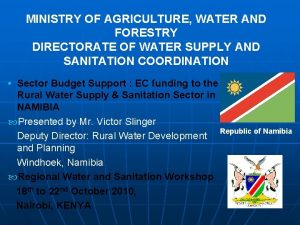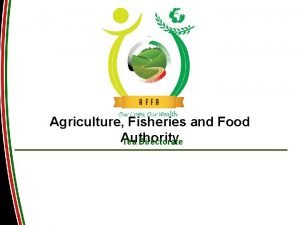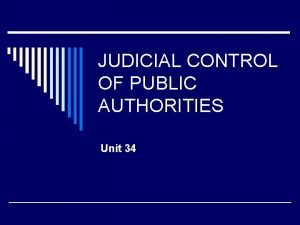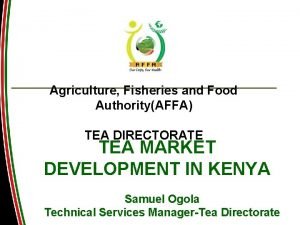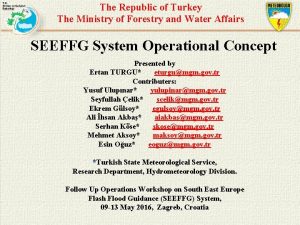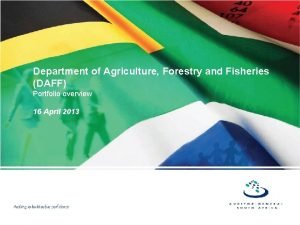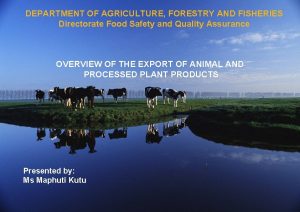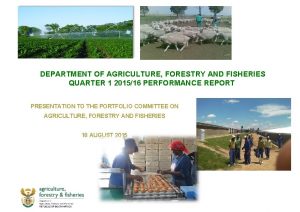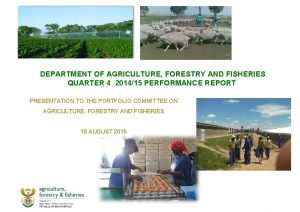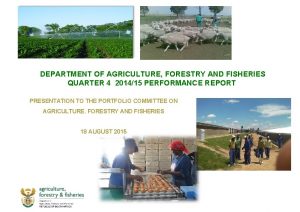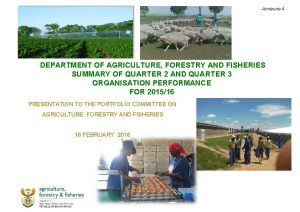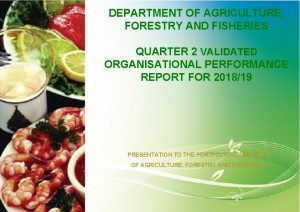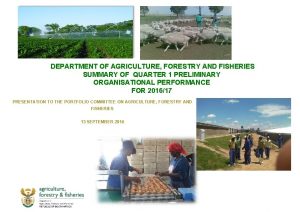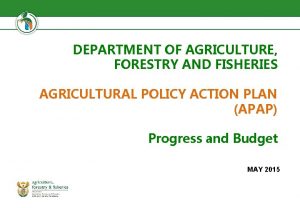DEPARTMENT of AGRICULTURE FORESTRY and FISHERIES Water Sector










- Slides: 10

DEPARTMENT of AGRICULTURE, FORESTRY and FISHERIES Water Sector Leadership Group Meeting 18 -19 November 2009

Mandate • The mandate of the department is derived from Section 24 b(iii) and 27 (1 b & 2) of the Constitution which states the following: • Section 24 b (iii): “Everyone has the right to have the environment protected, for the benefit of present and future generations, through reasonable legislative and other measures that secure ecologically sustainable development and use of natural resources while promoting justifiable economic and social development. • Section 27 (1 b): Everyone has the right to have access to sufficient food & water • Section 27 (2): The state must take reasonable legislative and other measures, within its available resources, to achieve the progressive realization of these rights. 2

Production and Resources Management Purpose • To promote agricultural productivity and profitability through the identification of opportunities, sustainable use and protection of land, water and genetic resources and infrastructure development to ensure household food security 3

Background • According to the National Water Resources Strategy (NWRS)(2002), around 60% of all water in the country is used for irrigation agriculture. • The NWRS also states that water resources developments have continuously evolved to meet the socio-economic needs of the country, within the constraints of Nature and whilst attention was mainly focused on development of new resources, the efficiency of water use was not developed to the same level of sophistication. • In 2007, the Department developed the Irrigation Strategy which amongst other issues, attempts to address the efficient use of water for irrigation purposes. 4

Background • It is estimated that approximately 1. 3 million ha is under irrigation – which amounts to ca 1. 5% agricultural land or 10% of the cultivated land. • Revitalization: There about 453 (317 smallholder) irrigation schemes in the country, where a large number are suffering reduced efficiency or have collapsed. Some commercial irrigation schemes are under-utilised and are in need of upgrading. • New Developments: Aligned to development initiatives and programmes of government • Management irrigated agriculture: Research on high irrigation water use efficiency and profitability, education & training of extension officers, farmers and specialists in the country 5

Institutional arrangements • A number of government departments and institutions are involved in the delivery of agricultural services. As a result, coordinating bodies on various levels of government have been established. These include the following: • Water User Associations • Co-ordination Committees for Agricultural Water • The Letsema-Ilima Water Resources and Irrigation Working Group • ITCA/ Min MEC • Agriculture Water Committee • Participation of DAFF in development initiatives (e. g. CRDP etc) where agrarian input is required. 6

Revitalization & development initiatives planned in provinces Province Eastern Cape Number of schemes/ extent 6 Issue to be addressed Time-Frame Revitalization of infrastructure 2009 - 2014 Free State PIE (3000 ha) 14 New developments Revitalization At different stages of implementation Gauteng HFS (18. 9 ha) New developments Not indicated Kwa-Zulu Natal ca 10 550 ha Revitalization 2009 – 2012 Limpopo ca 20 000 ha RESIS 2009 – 2014 Mpumalanga ca 90 000 ha New developments and revitalization 2009 – 2014 Northern Cape ca 32 000 ha New developments & revitalization North Western Cape 3 500 ha Revitalization 7

Challenges • Financial implications • Operational costs • Capital costs • Existing funding • Lack of irrigation specialists • Climate change • Resource base 8

Way forward • Co-ordinate and lead the Water Use and Irrigation Working Group • Participation and support in relevant forums relating to agriculture water use • Participation and support in initiatives which addresses revitalization and development of areas under irrigation • Support research on irrigation related issues • Support the training of extension, farmers and experts in irrigation • Effective liaison and cooperation with DWA • Develop a national centre of knowledge and information on irrigated agriculture 9

THANK YOU 10
 Maine department of agriculture conservation and forestry
Maine department of agriculture conservation and forestry Ministry of agriculture, water and forestry directorates
Ministry of agriculture, water and forestry directorates Tea directorate
Tea directorate Ministry of food agriculture and fisheries denmark
Ministry of food agriculture and fisheries denmark Allingham v minister of agriculture and fisheries
Allingham v minister of agriculture and fisheries Agriculture fisheries and food authority
Agriculture fisheries and food authority Mendel university fees
Mendel university fees Eturgu
Eturgu Water and water and water water
Water and water and water water Florida department of agriculture and consumer services
Florida department of agriculture and consumer services Virginia department of agriculture and consumer services
Virginia department of agriculture and consumer services

